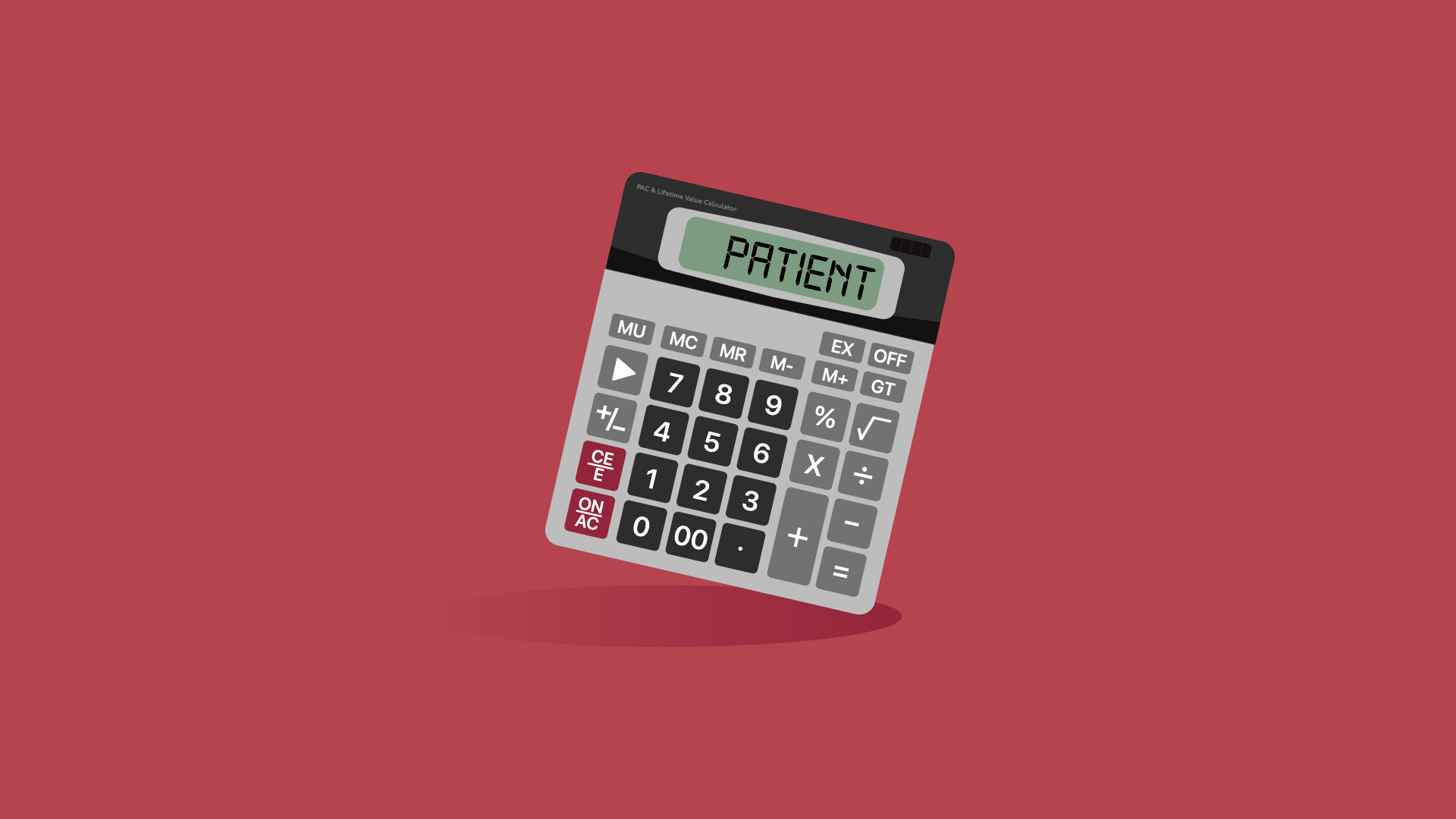How to Reduce Patient Acquisition Cost and Increase Lifetime Patient Value
In today’s competitive healthcare landscape, understanding the cost of acquiring new patients and the value they bring to your practice over their lifetime is crucial. In fact, this is like using a stethoscope to monitor the health of your patients. Just like you listen to their heartbeat to diagnose their condition, you need to regularly monitor patient acquisition cost and lifetime patient value to determine the health of your healthcare organization.
This way, you can make informed decisions about where to allocate resources, how to improve marketing efforts, and ultimately increase your bottom line. However, it’s not enough to simply understand these metrics – finding ways to reduce patient acquisition cost is equally important.
How Much Are You Investing in Growing Your Practice?
Patient acquisition cost (PAC) is the total cost of finding and acquiring a new patient. This includes all the expenses related to marketing, advertising, and promotional activities used to attract new patients to your healthcare organization. For example, let’s say you spend $1,000 on marketing efforts in a month, and during that same month, you acquire ten new patients. Your PAC for that month would be $100 per patient ($1,000/10 patients).
Without a solid understanding of the cost of bringing in each new patient via different channels, it can be difficult to know when and where to invest your time and money. On the other hand, calculating your PAC is a great way to understand how much you’re investing in growing your practice. This can help you identify strategies that are working and those that aren’t, so you can direct your marketing spend and reduce patient acquisition cost.
Add Lifetime Patient Value to the Equation
Lifetime patient value (LPV) is the total revenue generated by a patient during their lifetime as a customer of your healthcare organization. This covers the patient’s value beyond the initial visit or appointment. In other words, this is the amount of money that a patient is likely to spend in your practice over time. Suppose a patient visits your practice for a routine check-up and spends $100. If they return for follow-up appointments, buy products, refer family and friends, and leave you a 5-star Google review, their LPV will be much higher than the initial $100.
Measuring your LPV helps you understand how your PAC translates into long-term gains. Generally, the PAC needs to be lower than the LPV, so your ultimate goal should be to increase the margin between them. The larger the margin, the bigger your return on investment (ROI).
Reduce Patient Acquisition Cost to Grow Your Practice
 There’s no doubt that acquiring patients has become harder. In the last 5 years, the way customers interact with businesses has changed, their trust has eroded, and they have become more impatient. As marketing is getting more expensive, it’s more important to get a complete picture of how much it costs you to bring in a patient, and what that patient is worth to you instead of guessing how much you’re spending and getting in return.
There’s no doubt that acquiring patients has become harder. In the last 5 years, the way customers interact with businesses has changed, their trust has eroded, and they have become more impatient. As marketing is getting more expensive, it’s more important to get a complete picture of how much it costs you to bring in a patient, and what that patient is worth to you instead of guessing how much you’re spending and getting in return.
Even if you think your results are good, chances are there is always room for improvement and cost savings. So, in addition to measuring your PAC and LPV, it’s equally important to find effective ways to reduce patient acquisition cost, minimize them, and boost conversion rates.
Achieve More with Less
One of the most effective ways to reduce patient acquisition cost is to determine which of your marketing channels have the lowest PAC, so you know where to double down on your marketing spend. Once you understand the cost-effectiveness of your patient acquisition strategies, you can allocate your marketing resources more efficiently and achieve better results with a fixed budget amount. In return, you can maximize your ROI while lowering your marketing spend.
This approach also provides you with data-driven insights that help you make better decisions about where to focus your marketing efforts and which channels to prioritize. For example, you may learn that your Google Ads campaign is generating a high number of new patient inquiries, but the cost per patient is much higher compared to other marketing channels. To lower your marketing spend, you may decide to focus more on social media, but also adjust your Google Ads strategy, improve its targeting and ad copy, and ensure better results.
Apart from this, you can track the results of other marketing channels in a number of ways. To measure the effectiveness of your reputation management strategies, you can analyze the number of reviews and ratings received and the overall sentiment and tone of reviews. This can help you realize that you need to take additional measures, such as encouraging your patients to share their feedback by sending them automated review requests. You can also find out if there’s anything you can do to rank better in local search results by tracking the number of clicks, impressions, and actions taken on your Google Business Profile (GBP) or using Google Analytics to monitor website traffic coming from your GBP page. In addition to this, you can use call tracking to determine the effectiveness of your marketing efforts. Once you identify the source of phone inquiries, you can see which channels are attracting more high-quality patients and learn if there are any areas for improvement.
Identifying cost-effective marketing channels and making necessary adjustments helps you both reduce your patient acquisition cost and increase profitability. However, there are some limits that you need to be aware of. Calculating PAC per channel requires gathering and analyzing data from multiple sources, which can be time-consuming and complex. Also, the accuracy of this strategy depends on the quality of the data used — if it’s inaccurate or incomplete, the results you get may be unreliable.
Focus on Conversion Rates
Another way to change your PAC is by increasing conversion rates. When you focus on patients who are more likely to convert, you can streamline operations and acquire more of them with the same marketing budget. Also, if you provide a better patient experience, you can improve patient retention rates and reduce the need for ongoing marketing efforts to attract new patients, further reducing patient acquisition cost.
For example, your website is often one of the first impressions patients have of your practice, and it can have a significant impact on whether they choose to schedule an appointment or not. To increase the chances of conversion, you have to make sure that your website is user-friendly, easy to navigate, mobile responsive, and has a clear call to action.
Making it easy for patients to schedule appointments directly from your website is another effective way to boost conversion rates. To ensure this, your appointment booking form should be simple, straightforward, and prominently displayed, so patients can find it easily and schedule appointments without a hassle. You should also consider online scheduling as this can be a major convenience for patients. Also, once they submit a request, make sure to follow up promptly to confirm the appointment and answer any questions they may have.
In addition to this, you can use predictive targeting to increase conversion rates by identifying and reaching the right patients at the right time. Targeting specific audiences and addressing their unique pain points and concerns improves patient engagement and their health outcomes, but also helps you allocate resources more efficiently and improve ROI. Also, reaching patients through the right channels at the right time helps you build trust and strengthen patient-provider relationships.
At the same time, increasing conversion rates can take time and resources. Redesigning a website, optimizing appointment booking forms, or creating content that meets specific patients’ needs and preferences can be a significant investment, especially for healthcare organizations with limited marketing budgets. This is also a process that requires ongoing optimization and it may take several months to see a significant improvement in conversion rates. Finally, it can be challenging to determine what changes are driving the increase and how to distribute your resources.
It’s All About Making Strategic Decisions
Measuring PAC and LTV is essential for healthcare providers who want to achieve their business objectives. With these metrics, you can gain insight into the effectiveness of your marketing efforts, understand the value of your patients, and decide how to use available resources effectively. By doing so, you can find ways to reduce patient acquisition cost and improve your ROI.
When deciding whether to reduce patient acquisition cost by lowering marketing spend or increasing conversion, it’s important to remember that neither of these strategies is a standalone solution. To create a comprehensive marketing strategy, it’s important to consider other factors, such as the quality of acquired patients or the overall cost of your marketing campaign. For this reason, you need to use different metrics and contexts to gain a more accurate and complete understanding of the effectiveness of your marketing efforts.
At the same time, finding ways to reduce patient acquisition cost can be challenging for a number of reasons. Many healthcare providers have limited resources, including time, staff, and marketing budgets. Also, to adjust marketing strategies it may be necessary to analyze different patient data, including demographics, health conditions, and behaviors while staying compliant with strict rules and regulations.
If you find balancing your marketing efforts and providing high-quality care too demanding, you can use SocialClimb’s platform to streamline your marketing efforts and reduce costs. With our highly-intuitive set of tools, you can automate everything from patient acquisition, targeting patients who are likely to convert, and centralizing reputation management to optimizing other healthcare marketing efforts. In addition, you get real-time data and analytics on the performance of your marketing campaigns and online reputation, so you can make data-driven, strategic decisions to acquire new patients while reducing costs.











